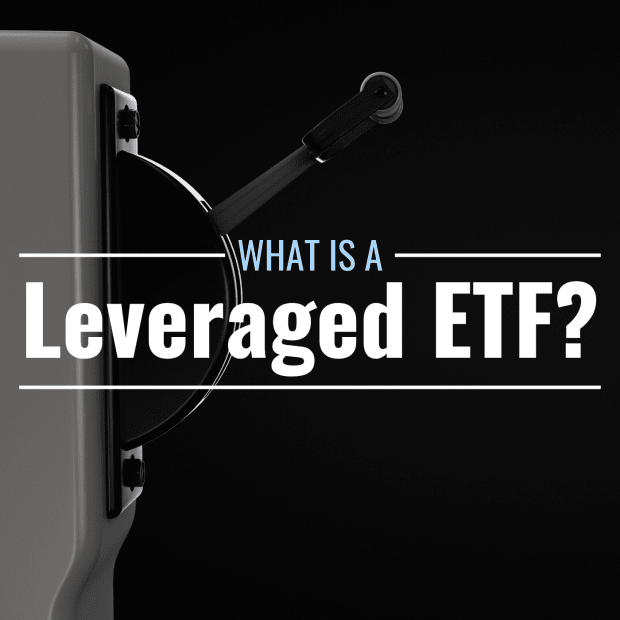
What Are Leveraged ETFs & How Do They Work?
Like traditional exchange-traded funds, leveraged ETFs are pooled investment vehicles that allow investors to gain exposure to many related assets with a single investment. Also like traditional ETFs, most leveraged ETFs track a stock index (like the Dow Jones Industrial Average) or a particular industry (like real estate or transportation).
Unlike their traditional counterparts, however, leveraged ETFs are designed to amplify daily returns by using derivatives (like swaps and options) and leverage (borrowed money). Most leveraged ETFs specify a ratio by which the returns of the underlying index will be multiplied (e.g., 2X, 3X, and so on).
For example, let’s say there was a 3X leveraged S&P 500 ETF. If the S&P 500 went up by 5% during a given trading session, the leveraged ETF would go up by about 15% in that same trading session. Alternatively, if the S&P lost 10% of its value, the 3X leveraged ETF would drop by a startling 30%.
How Long Should Leveraged ETFs Be Held For?
Unlike traditional ETFs, leveraged ETFs are not designed to serve as “buy-and-hold” investments. Instead, they function as speculative short-term trading vehicles.
On a daily basis, leveraged ETFs tend to track and multiply the returns of their target index (or sector) fairly accurately, but due to the derivative instruments used in their construction, their returns tend to deviate from those of their targets (often in a negative direction) the longer they are held. For this reason, traders typically buy and sell leveraged ETFs over very short periods (e.g., daily or intraday).
How Risky Are Leveraged ETFs?
Leveraged ETFs are very risky and should generally be avoided by long-term and passive investors. They are designed for very active, market-watching traders with shorter time horizons. Leveraged ETFs multiply the returns of the indexes they track—usually by 200% or 300%—so even if bought and resold over the course of a single trading session, they can produce significant losses.
Asa mentioned above, leveraged ETFs are usually constructed in such a way that they should not be held for more than a day or so. Leveraged ETFs become riskier the longer they are held, as the compounding nature of their returns can amplify losses and minimize gains over time, especially during periods of volatility. This phenomenon is known as “volatility decay.”
Leveraged ETF Examples: Direxion Daily Real Estate Bull (DRN) and Bear (DRV) ETFs
One popular leveraged ETF is the Direxion Daily Real Estate Bull ETF (DRN). This fund tracks the Real Estate Select Sector Index and seeks daily results equal to 300% of the returns (or losses) of that index. The same company also offers the Direxion Daily Real Estate Bear ETF (DRV). This is an inverse ETF that aims to produce returns equal and opposite to 300% of the returns of the Real Estate Select Sector Index.
A trader that follows the real estate industry closely might use one of these funds or the other depending on their short-term predictions and expectations regarding the real estate industry. For instance, if they expected a small selloff in mortgage providers in the aftermath of an interest rate announcement by the Federal Reserve, they might buy a share of the Direxion Daily Real Estate Bear ETF pre-market and then sell for a profit before the end of the day’s trading session.
What Fees Do Leveraged ETFs Charge?
Like traditional ETFs, leveraged ETFs charge investors a fee known as an expense ratio. Expense ratios are so-called because they are the ratio of a fund’s total expenses to its total assets. This ratio, expressed as a percentage, is charged to all of an ETF’s investors on an annual basis.
Most traditional ETFs are passively managed, so they tend to have fewer expenses than leveraged ETFs, which are actively managed. Expense ratios for traditional ETFs usually range from around 0.03% to 0.4%, while expense ratios for leveraged ETFs tend to average around 1.0%. This is because leveraged ETF managers must pay fees regularly to rebalance the ETFs portfolio, initiate new transactions, and pay interest on borrowed money.
What Sorts of Investors Should Use Leveraged ETFs?
Leveraged ETFs are created purposefully to be risky and volatile, as these characteristics allow for a larger potential upside over a very short holding period. For this reason, they are ideal for risk-friendly traders who like to make short-term bets about the direction an index’s price will go over the course of a few hours or a single trading session—usually due to factors like industry-specific news, earnings reports, or economic data releases.
Seasoned, professional traders can certainly use leveraged ETFs to their advantage, but they pose much more risk than potential upside to the average passive investor and should thus be avoided by most.
Frequently Asked Questions (FAQ)
Below are answers to some of the most common questions investors have about leveraged ETFs.
Can You Lose More Than You Invested in a Leveraged ETF?
No; even though leveraged ETFs use borrowed funds, investors cannot lose more than they invested in a leveraged ETF (assuming they didn’t buy it on margin). For this reason, leveraged ETFs are less risky than margin investing and shorting, which involve borrowing money and stock, respectively.
Can Leveraged ETFs Go to Zero? Can They Go Negative?
Because they rebalance daily, leveraged ETFs usually never lose all of their value. They can, however, fall toward zero over time. If a leveraged ETF approaches zero, its manager typically liquidates its assets and pays out all remaining holders in cash.
How Are Gains From Leveraged ETFs Taxed?
Ideally, leveraged ETFs should not be held for much longer than a day. For this reason, any capital gains (or losses) realized from the sale of a leveraged ETF would be taxed at the short-term rate.







